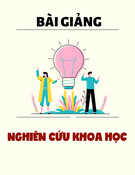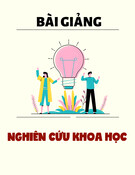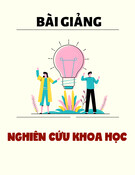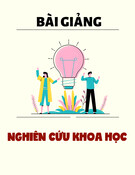
TNU Journal of Science and Technology 230(04): 468 - 476
http://jst.tnu.edu.vn 468 Email: jst@tnu.edu.vn
VIETNAMESE INSTRUCTORS’ PROGRESS IN TEACHING CONCEPTIONS
TOWARDS STUDENT- CENTEREDNESS
Duong Thi Ngoc Ngan
*
, Pham Ngoc Huyen
Kien Giang University
ARTICLE INFO ABSTRACT
Received:
12/03/2025
University instructors’ conceptions of teaching have long been a
significant
focus of educational research. However, the majority of previous studies have
concentrated on two opposing extremes: a completely teacher-
centered or a fully
learner-
centered model. Very few studies have explored the transitional process
betwee
n these two paradigms. To address this gap, the present study adopts
Kember’s theoretical framework on intermediate conceptions of teaching to
examine the shifting perceptions of a group of Vietnamese university instructors
regarding the nature of teaching
. Drawing on data collected from a survey (n =
310), semi-
structured interviews (n = 27), and classroom observations (n = 7),
the study reveals that lecturers have begun to move away from a purely teacher-
centered teaching model as they demonstrate an incr
easing awareness of the
principles underlying learner-
centeredness, namely defining learning objectives
in alignment with student needs; selecting teaching content in accordance with
student prior accumulation; employing interactive teaching methods;
implementing technology-
based teaching activities; promoting students
knowledge transfer ability and implementing formative assessment practices.
However, this learner-
centered transformation remains incomplete due to a
range of contextual factors including adm
inistrative pressures and rigid
curricula. This indicates
a transitional phase in teaching conceptions.
Revised:
30/04/2025
Published:
30/04/2025
KEYWORDS
Teacher–centered
Student–centered
Transitional teaching
conceptions
Vietnam
Reform
SỰ TIẾN BỘ TRONG QUAN NIỆM GIẢNG DẠY HƯỚNG ĐẾN LẤY NGƯỜI
HỌC LÀM TRUNG TÂM CỦA GIẢNG VIÊN VIỆT NAM
Dương Thị Ngọc Ngân
*
, Phạm Ngọc Huyền
Trư
ờ
ng Đ
ạ
i h
ọ
c Kiên Giang
THÔNG TIN BÀI BÁO TÓM TẮT
Ngày nhậ
n bài:
12/03/2025
Quan niệm giảng dạy của giảng viên đã từ lâu là trọng tâm của nhiều nghiên cứ
u
giáo dục. Tuy nhiên, phần lớn các nghiên cứu chỉ tập trung vào hai cực đối lậ
p:
giảng dạy hoàn toàn lấy giáo viên làm trung tâm hoặc hoàn toàn lấy người họ
c làm
trung tâm, trong khi giai đoạn chuyển tiếp giữa hai mô hình này vẫn chưa đượ
c
khám phá đầy đủ. Nhằm khắc phục những hạn chế còn tồn tại đó, nghiên cứ
u này
vận dụng khung lý thuyết của Kember về các quan niệm giảng dạy trung gian để
khảo sát sự thay đổi nhận thức của một nhóm giảng viên đại học Việt Nam về bả
n
chất của giảng dạy. Dữ liệu thu thập từ khảo sát (n = 310), phỏng vấn bán cấ
u trúc
(n = 27) và quan sát lớp học (n = 7) cho thấy nhiều giảng viên đã bắt đầu rời bỏ
mô hình dạy học thuần túy lấy giáo viên làm trung tâm vì đã nhận thức đượ
c các
nguyên lý dạy học lấy người học làm trung tâm, bao gồm việc xác định mụ
c tiêu
học tập gắn với nhu cầu của người học; lựa chọn nội dung phù hợp với kiến thứ
c
và kinh nghiệm của các em; sử dụng phương pháp dạy học tương tác; ứng dụ
ng
công nghệ thông tin; áp dụng kiến thức để giải quyết các vấn đề mới lạ ngoài thự
c
tế và triển khai đánh giá dựa trên quá trình. Tuy nhiên, việc chuyển đổi này vẫ
n
chưa hoàn thiện do giáo viên còn chịu ảnh hưởng từ các rào cản như áp lự
c hành
chính và chương trình đào tạo cứng nhắc. Kết quả nghiên cứu phản ánh sự tồn tạ
i
c
ủ
a m
ộ
t giai đo
ạ
n chuy
ể
n ti
ế
p trong quan ni
ệ
m gi
ả
ng d
ạ
y.
Ngày hoàn thiệ
n:
30/04/2025
Ngày đăng:
30/04/2025
TỪ KHÓA
Lấy giáo viên làm trung tâm
Lấy học sinh làm trung tâm
Dạy học theo hướng chuyển
giao
Việt Nam
Cái cách
DOI: https://doi.org/10.34238/tnu-jst.12280
Email: ngocngan0391@gmail.com

TNU Journal of Science and Technology 230(04): 468 - 476
http://jst.tnu.edu.vn 469 Email: jst@tnu.edu.vn
1. Introduction
Phenomenography argues that people experience the world differently because their experiences are
always partial [1]. At any given time and context, people notice and focus on different aspects of the
same phenomenon. This means that the way a person experiences something depends on which aspects
of the phenomenon they discerned, and not discerned, in their awareness of it. Awareness of an aspect
is indicated by the perception of the potential for variation in that aspect.
At the same time, each way of experiencing may be understood as part of a larger whole, the
collective sum of ways of experiencing. These different experiences are interconnected, as people
share awareness of certain aspects while differing in others. Thus, the different ways of
experiencing that emerge are not constituted independently, but in relation to each other. These
different ways of experiencing are commonly ordered in terms of inclusivity of awareness, where
more inclusive ways also represent more complex ways of experiencing the phenomenon. As such,
during phenomenographic data analysis for educational research, teaching conceptions held by
teachers are categorized in a structurally related hierarchy of inclusiveness.
Developed from a review on 1990’s educational studies, the model of multiple–level
categorization model of teaching conceptions [2], as shown in Figure 1, is the excellent reflection
of the inclusivity of awareness. In particular, the teaching views in the intermediate category:
teacher-student interaction are more advanced than those in the teachers-centered category at the
one end of the continuum. Indeed, instructors-participants in the mediating category assist students
in actively integrating new textbook content into their existing knowledge. In contrast, those in
latter tend to disregard this tutorial support because they focus mainly on students memorizing
factual information rather than engaging in deeper learning [2].
As also manifested at the outset, teaching views are categorized based on teachers’ awareness
of key aspects. This awareness is reflected in their ability to recognize different potential variations
in those aspects. Hence, the intermediate category is still less advanced than the learner-centered
category at the opposite end of the continuum. In fact, instructors in both categories understand the
importance of cognitive engagement but those in the truly learner-centered category also recognize
the humanistic aspects associated with this cognitive integration. This deeper understanding is
evidenced in how they empowered students to freely criticize the input as they build their own
knowledge [2]. In this context, the instructors in the intermediate category have moved beyond
traditional teaching owing to their recognition of aspects of teaching that are overlooked by their
strictly teaching-centered counterparts. At the same time, the former still has yet to grasp the key
principles needed to become truly student-centered teachers; hence, they merely stand at the
threshold of a more progressive orientation. To simply put, the intermediate category marks the
transitional shift from a purely teacher-centered toward a genuinely learner- oriented approach.
Learner–oriented teaching is increasingly recognized a vital strategy for educational reform globally
and recently has been imported into the Eastern from the Western context as a reform model for higher
education (HE) [3]. The push for shifting to this learning even gets stronger in Vietnam [4] as
Vietnamese HE is undergoing a comprehensive and profound reform process to meet the demands of
industrialization, modernization, and international integration. Indeed, Resolution No. 29-NQ/TW
issued in 2013 laid the foundation for a fundamental and comprehensive renovation of education,
aiming to develop a high-quality human resource to support the country’s sustainable development [5].
In this context, Vietnamese HE institutions are facing various challenges, such as the quality of training,
traditional teaching methods, and the need to innovate curricula and teaching practices. In response to
these challenges, universities in Vietnam have been implementing reform measures, one of which is the
adoption of learner-oriented teaching approaches [6], [7].
Vietnamese university instructors as its practitioners are vulnerable due to encountering socio-
cultural factors hampering their understanding of that teaching concept [8] - [10]. As such, this
current research assumes that it is important to apply Kember's concept of intermediate teaching

TNU Journal of Science and Technology 230(04): 468 - 476
http://jst.tnu.edu.vn 470 Email: jst@tnu.edu.vn
conceptions (ITC) to a search for indicators that signal instructors' transitional shift from a purely
teacher-centered approach toward a genuinely learner- oriented model. This is worthy of
discussion because of the insights it can uncover on the study participants’ perceptions of the
potential for variation in teaching aspects not yet discerned before. Those data could inform the
design of professional support strategies and administrative interventions aimed at their greater
accommodation towards student–centered teaching. Due to the considerable paucity of in–depth
research on ITC in HE context, this current study seeks to contribute to the existing literature. In
particular, it aims to answer the following research question: What indicators signify the transition
of Vietnamese university instructors’ shift from a purely teacher-centered to a more student-
centered approach?
Figure 1. Multiple–level categorization model of teaching conceptions [2]
2. Research Method
2.1. Research design
Aware of the complexities involved in authentically identifying the participants’ conceptual
teaching development, this study employed a mixed–methods approach [11]. Indeed, the
interviews can provide nuanced insights into the participants’ scale of beliefs of and plans on
teaching, allowing for comparisons between the qualitative and quantitative self–reports.
Additionally, classroom observations reveal discrepancies as well as insights from real–time
practice that often remain hidden when relying solely on scaled data and interviews.
2.2. Sample
A total of 310 participants aged from under 25 to over 45 (64.6% male and 35.4% female) from
various disciplines including natural science (mathematics, physics, chemistry, agriculture), and
social science (economics, languages) volunteered to participate. Ultimately, 307 surveys were
completed, in addition to 27 interviews and 7 classroom observations of interviewees.
2.3. Instruments
2.3.1. Questionnaires
This study adopted the Cognitivist Constructivist-Oriented Teaching Conception (CCOTC)
questionnaire by [9]. It assesses teaching beliefs and teaching intentions that do not fit strictly
within teacher- or student-centered paradigms through a 21-item survey (5-point Likert scale: 1 =
total disagreement; 5 = total agreement) for the former and another 21-item survey for the latter (1
= almost never; 5 = usually). The result of Cronbach alpha(α) for the dimensions of teachers’ beliefs
and teachers’ intentions scale was as follows: Teaching (α = 0.79; 0.81); Teacher (α = 0.94; 0.90);
Students (α = 0.96, 0.95) in the scale of teaching beliefs and that of intentions, respectively.
2.3.2. Interview and observations
A set of interview questions was adapted from relevant literature [12]. The first question, "What
does teaching mean to you?" aimed to capture the interviewees' personal definitions of teaching,

TNU Journal of Science and Technology 230(04): 468 - 476
http://jst.tnu.edu.vn 471 Email: jst@tnu.edu.vn
thereby eliciting a general conceptual understanding of teaching among participants. A series of
follow-up questions were used to obtain a comprehensive description of their conceptual views,
intentional strategies, and actual practices related to the teaching phenomenon (e.g., "What are the
foundations of effective teaching?"; "What constitutes effective teaching and learning
assessment?"; "What are your intentions for achieving teaching objectives?"; "Please describe your
teaching practices in recent lessons"). Additionally, probing questions (e.g., "What makes you say
that?") were incorporated to elicit deeper and more expanded insights on the same issues. The
objectives of the classroom observations included aspects of how teachers pedagogically addressed
various teaching aspects such as instruction (the roles of teachers and learners, teaching
activities…), learning assessments, (feedback provision…) among others.
2.4. Data administration
Questionnaires were distributed physically. The survey was conducted over a period of three
weeks to ensure sufficient time for 310 instructors to complete the questionnaire fully. Upon
completing the survey, respondents indicated their willingness to participate in interviews and
classroom observations by providing their contact information on the questionnaire. In the
qualitative phase, participants selected for interviews were contacted two days prior to the
interview. Interviews were conducted in a private room to ensure confidentiality, were audio–
recorded, and lasted between 46 and 58 minutes. Observed participants were contacted one week
before the observation sessions.
2.5. Data analysis
The CCOTC assessed participants' teaching beliefs and intentions. T-tests were conducted to
examine gender differences whereas ANOVA was used for age and teaching experience
discrepancies. Qualitative data from interview transcripts were analyzed using ATLAS.ti. A third-
party lecturer of Vietnamese literature assisted in coding, and inductive analysis identified patterns
in teaching awareness, plans, and practices.
3. Results and Discussion
3.1. Questionnaires
3.1.1. Instructors’ views of teaching
The research findings indicate that the majority of lecturers have a positive perception of learner-
centeredness, particularly in exhibiting their stronger support for the construct of Teaching
and Teacher than that of Student, with the highest level of agreement on aligning learning objectives
with students’ needs as well as their prior accumulation and adopting interactive teaching for student
critical thinking ability respectively. With respect to the Student factor, the strongest endorsement
is on student viewing their teachers as tutors rather than knowledge transmitters.
These positive findings can be attributed to several interrelated factors. First, national
educational reforms emphasizing outcome-based and competency-oriented curricula have
encouraged university instructors to align learning objectives with students' real-world needs [13].
Second, professional development programs have equipped lecturers with the knowledge to design
interactive and integrative learning experiences, as stipulated in the Ministry of Education and
Training’s Decision No. 1079/QĐ-BGDĐT [10].
t-test analysis revealed statistically significant mean differences in levels of agreement based
on respondents' genders (p < 0.05). Specifically, the findings suggest that the female’s mean is 0.81
(SD = 1.02) while 0.83 is that of their counterpart (SD = 1.32), t = 2.65, and p = 0.01. The average
of all male scale participants’ beliefs is slightly stronger than that of female’s (Mmale = 4.33,
SD = 0.55, Mfemale = 4.26, and SD = 0.45). The current findings reinforce the notion that perception
plays a crucial role in shifting from traditional teaching to a learner-centered approach. ANOVA

TNU Journal of Science and Technology 230(04): 468 - 476
http://jst.tnu.edu.vn 472 Email: jst@tnu.edu.vn
analysis revealed statistically insignificant mean differences in levels of agreement influenced by
age, and teaching experience (p > 0.05).
3.1.2. Instructors’ planning on teaching practice
Statistical analysis of the item responses shows a direct connection between what respondents
profess to believe and what they intend to enact. This alignment is most evident in areas of the use
of interactive teaching methods where many respondents reported frequently using small group
discussions to foster student engagement. The belief-practice relationship is also demonstrated
with the scale respondents' selection of syllabus content appropriate with students' development of
cognitive level. Likewise, the use of diversified formative assessment methods such as peer
evaluations aimed at evaluating students based on competencies manifests that relationship. The
findings regarding the awareness-performance alignment are in keeping with the results of the
studies in the same fields [12]. The t-test revealed significant mean differences in instructional
intentions based on the respondents’ gender (Mmale = 0.85, SD = 1.47, Mfemale = 0.89, and SD =
1.02), t = 2.35, and p = 0.01, whereas ANOVA analysis revealed statistically insignificant mean
differences in agreement in term of age and experience of teaching (p > 0.05).
In short, the scale data reveal that respondents recognize progressive aspects of teaching
overlooked in the teacher-centered model, arguing [5]’s argument. The scale findings show the
studied participants’ conceptual development and reflect emerging progress in Vietnamese
HE. Practically, the results illuminate the professional development and stronger institutional
support. They also report intentions to implement the teaching practices they value, challenging
the finding of [12]. Regarding methodological contribution, the results emphasize the need to
employ both scales to increase the reliability of the survey results.
3.2. Interview analysis
This study aims to assess Vietnamese university instructors' progress in understanding and
practicing teaching. Thematic analysis of interviews with 27 participants identified three key
themes: (1) content, (2) methods, and (3) assessments in teaching and learning.
3.2.1. Teaching and learning content
Subthemes within this category include the balance between theory and practice, the selection of
learning content, and the relationship between teaching materials and learners’ prior accumulation.
Contrary to [3]’s claim that Vietnamese instructors prioritize theory-heavy curricula, none of
the interviewees associated teaching with increasing the practicality of materials. Instead,
throughout the interviews, participants consistently associated their views of teaching with the
syllabus's connection to learners’ prior experiences and knowledge. A young male skills instructor
from Faculty B noted:
“If teaching content isn’t grounded in what students have previously learned, they lack the
necessary background to understand new input.”
Consistent with research on progressive teaching, which emphasizes the importance of
meaningful learning, 22.5% of interviewed instructors reported allowing students to choose content
they find essential. However, they also expressed a preference for restricting these choices to "a
carefully studied list of topics" to ensure syllabus coverage.
3.2.2 Teaching and learning methods
The predominant subthemes identified included (1) encouraging active learning, (2) employing
traditional lecturing methods, (3) promoting classroom interactions, (4) employing technology-
based teaching, (5) enhancing cognitive integration, and (6) fostering transfer knowledge.
In contrast to the findings of [2], [3] which characterized instructors as mere communicators of
correct answers to students, the interviewees strongly agreed on thinking of themselves as guides



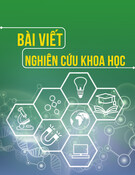


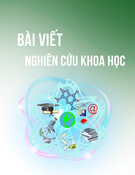


![Câu hỏi ôn tập môn Tâm lý học giáo dục [chuẩn nhất]](https://cdn.tailieu.vn/images/document/thumbnail/2025/20250710/kimphuong1001/135x160/59611752136982.jpg)
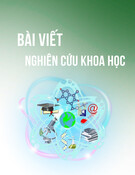



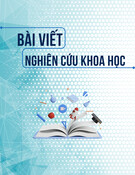
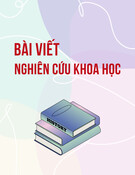
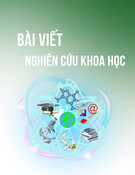

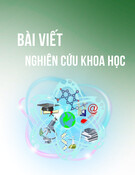


![Định hướng giáo dục STEM trong trường trung học: Tài liệu [chuẩn/mới nhất]](https://cdn.tailieu.vn/images/document/thumbnail/2025/20251124/dbui65015@gmail.com/135x160/25561764038505.jpg)
